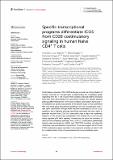Por favor, use este identificador para citar o enlazar a este item:
http://hdl.handle.net/10261/280405COMPARTIR / EXPORTAR:
 SHARE SHARE
 CORE
BASE CORE
BASE
|
|
| Visualizar otros formatos: MARC | Dublin Core | RDF | ORE | MODS | METS | DIDL | DATACITE | |

| Título: | Specific transcriptional programs differentiate ICOS from CD28 costimulatory signaling in human Naïve CD4+ T cells |
Autor: | Gigliotti, Casimiro Luca; Boggio, Elena; Favero, Francesco; Incarnato, Danny; Santoro, Carlo; Oliviero, Salvatore; Rojo, José María CSIC ORCID CVN ; Zucchelli, Silvia; Persichetti, Francesca; Baldanzi, Gianluca; Dianzani, Umberto; Corá, Davide | Fecha de publicación: | 5-sep-2022 | Editor: | Frontiers Media | Citación: | Frontiers in Immunology 13: 915963 (2022) | Resumen: | Costimulatory molecules of the CD28 family play a crucial role in the activation of immune responses in T lymphocytes, complementing and modulating signals originating from the T-cell receptor (TCR) complex. Although distinct functional roles have been demonstrated for each family member, the specific signaling pathways differentiating ICOS- from CD28-mediated costimulation during early T-cell activation are poorly characterized. In the present study, we have performed RNA-Seq-based global transcriptome profiling of anti-CD3-treated naïve CD4+ T cells upon costimulation through either inducible costimulator (ICOS) or CD28, revealing a set of signaling pathways specifically associated with each signal. In particular, we show that CD3/ICOS costimulation plays a major role in pathways related to STAT3 function and osteoarthritis (OA), whereas the CD3/CD28 axis mainly regulates p38 MAPK signaling. Furthermore, we report the activation of distinct immunometabolic pathways, with CD3/ICOS costimulation preferentially targeting glycosaminoglycans (GAGs) and CD3/CD28 regulating mitochondrial respiratory chain and cholesterol biosynthesis. These data suggest that ICOS and CD28 costimulatory signals play distinct roles during the activation of naïve T cells by modulating distinct sets of immunological and immunometabolic genes. | Descripción: | 14 p.-5 fig. This work is dedicated to the memory of our colleague SZ. SZ was an extraordinary person, a great friend, a remarkable scholar and an unfailing mentor for our students. Her passion for life and research will always be an example. We miss her a lot. | Versión del editor: | https://doi.org/10.3389/fimmu.2022.915963 | URI: | http://hdl.handle.net/10261/280405 | DOI: | 10.3389/fimmu.2022.915963 | ISSN: | 1664-3224 |
| Aparece en las colecciones: | (CIB) Artículos |
Ficheros en este ítem:
| Fichero | Descripción | Tamaño | Formato | |
|---|---|---|---|---|
| fimmu_gigliotti_2022.pdf | Artículo principal | 2,52 MB | Adobe PDF |  Visualizar/Abrir |
CORE Recommender
SCOPUSTM
Citations
1
checked on 22-abr-2024
Page view(s)
50
checked on 01-may-2024
Download(s)
43
checked on 01-may-2024
Google ScholarTM
Check
Altmetric
Altmetric
Este item está licenciado bajo una Licencia Creative Commons

